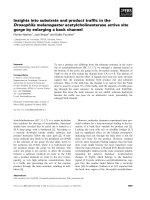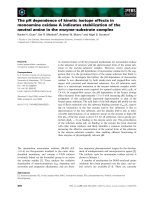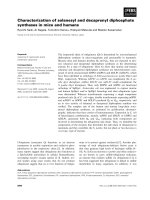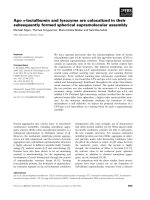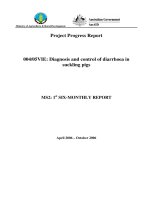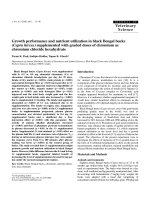Báo cáo khoa học: "Growth, gas exchange and carbon isotope discrimination in young Prunus avium trees growing with or without individual lateral shelters" doc
Bạn đang xem bản rút gọn của tài liệu. Xem và tải ngay bản đầy đủ của tài liệu tại đây (684.46 KB, 10 trang )
Original
article
Growth,
gas
exchange
and
carbon
isotope
discrimination
in
young
Prunus
avium
trees
growing
with
or
without
individual
lateral
shelters
C
Collet
A
Ferhi
JM
Guehl
3
H
Frochot
1
INRA,
centre
de
Nancy,
laboratoire
Lois
de
Croissance,
F-54280
Champenoux;
2
Centre
de
recherches
géodynamiques,
université
Paris
VI,
47,
avenue
de
Corzent,
F-74203
Thonon-les-Bains;
3
INRA,
centre
de
Nancy,
laboratoire
de
Bioclimatologie
et
d’Écophysiologie
forestières,
F-54280
Champenoux,
France
(Received
3
November
1992;
accepted
5
February
1993)
Summary —
One-yr-old
wild
cherry
(Prunus
avium
L)
plants
were
grown
as
follows:
1)
in
small
cylin-
drical
shelters
(diameter
50
cm,
treatment
S);
2)
in
large
shelters
(diameter
100
cm,
treatment
L);
or
3)
without
shelter
(control,
treatment
C)
during
1
growing
season.
Treatment
C
was
characterized
by
higher
values
of
photosynthetic
photon
flux
density
(I
p)
and
of
leaf-to-air
water
vapour
pressure
dif-
ference
(Δ
W)
than
treatments
L and
S.
The
plants
were
taller
in
treatments
L and
S
than
in
treatment
C
but
biomass
production
was
higher
in
the
latter
treatment.
The
plants
of
treatment
C
were
also
characterized
by
higher
values
of
CO
2
assimilation
rate
(A)
and
of
leaf
mass
per
unit
area
(LMA,
ra-
tio
of
leaf
mass
to
leaf
area).
Relative
carbon
isotope
composition
(δ
p)
of
the
leaves
was
higher
in
treatment
C
than
in
treatments
L and
S,
which
expresses
higher
time-integrated
values
of
plant
in-
trinsinc
water-use
efficiency
(A/g
ratio)
in
the
former
treatment.
There
was
a
positive
correlation
be-
tween
δ
p
and
LMA.
Thus,
LMA,
a
readily
measurable
parameter,
is
a
relevant
parameter
for
under-
standing
and
modelling
water-use
efficiency
of
canopies.
lateral
shelter
I
microclimate
I
growth
I
leaf
gas
exchange
I
carbon
isotope
discrimination
I
water-use
efficiency
/
leaf
mass
per
unit
area
Résumé —
Croissance,
échanges
gazeux
et
discrimination
isotopique
du
carbone
de
jeunes
merisiers
(Prunus
avium
L)
placés
ou
non
dans des
abris
latéraux
individuels.
Des
plants
de
merisier
(Prunus
avium
L)
âgés
de
1 an
ont
été
installés
durant
une
saison
de
végétation
dans 1)
des
petits
abris
cylindriques
(diamètre
50
cm,
traitement
S);
2)
des
grands
abris
cylindriques
(diamètre
100
cm,
traitement
L);
ou 3)
sans
abri
en
plein
découvert
(traitement
C)
(fig
1).
Le
traite-
ment
C
était
caractérisé
par
des
valeurs
plus
élevées
de
rayonnement
photosynthétiquement
actif
(
Ip)
ainsi
que
de
différence
de
pression
partielle
de
vapeur
d’eau
entre
feuille
et
atmosphère
(ΔW)
(fig
3).
La
croissance
en
hauteur
était
plus
élevée
pour
les
plants
du
traitement
C
que
pour
ceux
des
traitements
L
et
S,
alors
que
la
production
de
biomasse
était
la
plus
élevée
dans
le
traitement
C
(tableau
I).
Les
plants
du
traitement
C
étaient
également
caractérisés
par
des
valeurs
plus
élevées
de
taux
d’assimilation
de
CO
2
(A)
(fig
5)
ainsi
que
de
masse
foliaire
spécifique
(LMA,
rapport
de
la
masse
sur
la
surface
foliaire)
(fig
8).
La
composition
isotopique
relative
en
carbone
(δ
p)
des
feuilles
était
plus
élevée
dans
le
traitement
C
que
dans
les
traitements
L
et
S
(fig
8).
Cela
traduit
des
valeurs
intégrées
dans
le
temps
d’efficience
intrinsèque
d’utilisation
de
l’eau
(rapport
A/g)
plus
élevées
pour
le
traitement
C
(tableau
I).
On
a
noté
une
corrélation
positive
entre
δ
p
et
LMA
(fig
8).
Ainsi,
LMA,
qui
est
une
grandeur
facilement
mesurable,
constitue
un
paramètre
pertinent
pour
la
compréhension
et
la
modélisation
de
l’efficience
d’utilisation
de
l’eau
des
couverts
végétaux.
abri
latéral
/
microclimat
/
croissance
/
échanges
gazeux
foliaires
/
discrimination
isotopique
du
carbone
/
efficience
d’utilisation
de
l’eau
/
masse
foliaire
spécifique
INTRODUCTION
The
neighbourhood
relationships
between
young
trees
and
the
surrounding
vegeta-
tion
are
the
result
of
various
below-ground
(competition
for
water
and
nutrients,
alle-
lopathy)
and
above-ground
(competition
for
light,
modification
of
temperature,
air
humidity
and
windspeed)
interactions
(Gjerstad
et
al,
1984 ;
Radosevich
and Os-
teryoung,
1987).
When
neighbourhood
re-
lationships
are
dominated
by
competition
processes,
their
global
effect
will
be
to
re-
duce
survival
and
growth
of
the
young
trees.
However,
in
situations
of
high
poten-
tial
evapotranspiration,
the
presence
of
ac-
companying
vegetation
may
be
beneficial
for
the
trees
due
to
lowered
evaporative
demand
at
the
tree
level.
To
analyze
the
neighbourhood
relation-
ships
it
is
necessary
to
disentangle
the
ef-
fects
of
aerial
and
soil
factors
(Nambiar,
1990).
The
use
of
artificial
lateral
shelters
built
around
growing
young
trees
may
be
a
relevant
way
of
studying
the
effects
of
aeri-
al
microclimate
modifications
on
the
growth
and
function
of
plants
(Collet
and
Frochot,
1992).
The
general
effect
of
later-
al
shading
will
be
to
reduce
photosynthetic
CO
2
assimilation
due
to
lowered
leaf
inci-
dent
photosynthetic
photon
flux
density.
However,
this
reduction
may
be
accompa-
nied
by
a
decrease
in
stomatal
conduc-
tance
and
in
transpirational
water
losses
which
can
be
beneficial
for
the
plant
water
status
and
water-use
efficiency
(Aussenac
and
Ducrey,
1978).
This
study
examines
the
effects
of
artifi-
cial
lateral
shelters
simulating
the
aerial
ef-
fects
of
an
accompanying
vegetation -
without
any
below-ground
relationship -
on
young
Prunus
avium
trees.
Measurements
of:
1)
microclimatic
parameters ;
2)
growth ;
3)
leaf
gas
exchange ;
and
4)
leaf
carbon
isotope
composition
which
can
lead
to
time-integrated
plant
water-use
efficien-
cy
were
made.
MATERIAL
AND
METHODS
Experimental
design
Wild
cherry
(Prunus
avium
L)
seedlings
(Côte
d’Or
provenance,
Eastern
France)
were
grown
in
an
experimental
nursery
near
Limoges
(Mas-
sif
Central,
France)
from
spring
1989.
On
Febru-
ary
15
1990,
48
plants
(average
height
30
cm)
were
taken
from
the
nursery
beds.
In
order
to
minimize
transplanting
stress,
the
plants
were
immediately
placed
in
containers
filled
with
or-
ganic
soil
and
transferred
to
the
experimental
plot
near
Nancy
(northeastern
France)
where
they
were
planted.
The
trees
were
randomly
dis-
tributed
into
3
treatments
comprised
of
16
trees
each:
Treatment
S
(small
shelters).
These
plants
were
surrounded
by
individual
cylindrical
shelters
with
a
diameter
of
50
cm.
Treatment
L
(large
shelters).
These
plants
were
surrounded
by
cylindrical
shelters
with
a
diame-
ter
of
100
cm.
Treatment
C.
Controls
without
shelters.
The
shelters
were
constituted
of
a
wire
net-
ting
supporting
a
green
plastic
net
with
a
porosi-
ty
of
50%
(fig
1).
Initially,
the
shelters
were
60
cm
high.
As
the
seedlings
grew,
the
height
of
all
the
shelters
was
increased
so
that
no
plant
was
greater
than
its
shelter.
Four
successive
height
increases
were
made
simultaneously
for
all
shel-
ters
(fig
2).
At
the
end
of
the
growing
season
the
shelters
were
2.5
m
high.
Bare
soil
conditions
were
maintained
throughout
the
experiment
by
chemical
weeding
around
the
shelters
and
manual
weeding
within
the
shelters.
Rainfall
dur-
ing
the
experimental
period
(April-September)
amounted
to
262
mm
and
no
additional
water
was
supplied
to
the
trees.
In
order
to
assess
the
microclimatic
condi-
tions
inside
the
2
types
of
shelters,
photosyn-
thetic
photon
flux
density
(I
p)
was
measured
at
12.00
(solar
time)
on
a
sunny
day
with
a
quan-
tum
sensor
(Li-Cor,
Lincoln,
NE,
USA)
at
differ-
ent
heights
above
ground.
These
measure-
ments
were
made
when
the
shelters
were
1.5
m
high.
At
the
top
of
the
shelter
Ip
was
similar
to
that
outside
the
shelters
(100%).
Below
115
cm
(S
shelters)
and
75
cm
(L
shelters),
Ip
was
abruptly
reduced
to
30%
of
the
ouside
Ip
in
both
types
of
shelters.
Thus,
the
upper
parts
(= 30
cm
for
the
S
shelters
and
40
cm
for
the
L
shelters)
of
the
elongating
stems
were
exposed
to
full
sunlight
around
midday
while
the
lower
parts
were
shaded
all
day
long.
Water
status
and
gas
exchange
measurements
Water
status
and
gas
exchange
measurements
were
made
periodically
between
July
11
and
Au-
gust
16.
These
measurements
were
carried
out
on
the
6
tallest
plants
in
each
treatment
in
order
to
avoid
experimental
interference
due
to
trans-
planting
stress.
Predawn
leaf
water
potential
of
the
seedlings
was
measured
with
a
Scholander
pressure
chamber
and
was
between
-0.1
MPa
(July
11)
and
-0.45
MPa
(August
16),
thus
indi-
cating
an
absence
of
severe
drought
con-
straints.
Carbon
dioxide
assimilation
rate
(A,
μmol
m
-2
s
-1),
transpiration
rate
(E,
mmol
m
-2
s
-1
)
and
leaf
conductance
for
water
vapor
(g,
mmol
m
-2
s
-1
)
were
measured
using
a
LI-6200
portable
photosynthesis
system
(Li-Cor
Inc,
Lincoln,
Ne-
braska,
USA)
fitted
with
a
4-I
assimilation
cham-
ber.
Leaf
temperature
(T
1)
was
monitored
by
means
of
a
thermocouple
in
contact
with
the
lower
leaf
surface.
The
leaf-to-air
difference
in
water
vapour
partial
pressure
(ΔW)
was
calculat-
ed
from
T1
and
air
water
vapour
pressure.
Si-
multaneously
to
the
gas
exchange
measure-
ments,
Ip
was
measured
with
a
quantum
sensor
(Li-Cor,
Lincoln,
NE,
USA).
Preliminary
meas-
urements
were
carried
out
in
order
to
assess
the
effects
of
leaf
ageing
on
gas
exchange
parame-
ters.
A
and
g
were
highest
for
leaf
order
be-
tween
4
and
7.
All
gas
exchange
data
reported
hereafter
correspond
to
measurements
made
within
that
zone
of
the
trees
which,
in
the
shel-
ters,
was
generally
at
the
transition
between
the
shaded
and
the
full
sunlight
exposed
regions.
Gas
exchange
measurements
were
performed
between
11.30
and
13.30
(UT)
on
2
leaves
per
tree.
Gas
exchange
parameters
were
calculated
on
a
leaf
area
basis.
Leaf
area
was
determined
in
situ
just
prior
to
the
gas
exchange
measure-
ments
by
means
of
a
portable
area
meter
(Licor
3000,
Li-Cor,
Lincoln,
NE,
USA).
Carbon
isotopic
composition
Carbon
isotopic
composition
was
determined
on
leaf
material.
Three
leaves
from
each
of
the
6
trees
in
the
different
treatments
were
harvested
on
October
12.
These
leaves
included
those
in
which
gas
exchange
had
been
measured
on
August
8.
After
determination
of
leaf
area,
the
samples
were
oven-dried
at
70°C
for
48
h,
weighed
and
finely
ground.
Fifteen
mg
of
sam-
ple
material
was
then
weighed
out
and
com-
busted
in
special
quartz
vessels
under
a
pure
O2
atmosphere.
The
carbon
was
thus
quantita-
tively
converted
to
CO
2.
Relative
abundances
of
13
C
and
12
C
were
determined
using
a
mass
spectrometer
(Finigan
Mat).
The
results
are
ex-
pressed
in
terms
of
the
conventional
δ
‰
nota-
tion,
according
to
the
relation
(Farquhar
et
al,
1989):
δ=R
s
/R
b-
1
[1]
where
Rs
and
Rb
refer
to
13C/12
C
ratio
in
the
sample
and
in
the
Pee
Dee
Belemnite
standard
(PDB),
respectively.
RESULTS
Microclimate,
growth
and
gas
exchange
Gas
exchange
measurements
were
made
on
5
sunny
days
from
July
11
to
August
8
with
a
photosynthetic
photon
flux
density
(Ip)
of
≈
1 400
μmol
m
-2
s
-1
in
treatment
C
(full
sunlight)
(fig
3).
Air
temperature
(con-
trol
treatment)
increased
progressively
from
22.0°C
on
July
11
to
34°C
on
August
1
and
then
decreased
to
27°C
on
August
8.
Leaf-to-air
water
vapour
concentration
(ΔW)
presented
similar
time
changes
with
extreme
values
of
≈ 14
Pa
KPa
-1
and
34
Pa
KPa
-1
.
In
both
L and
S
treatments
Ip
was
approximately
half
that
in
C,
except
on
August
8
when
Ip
was
identical
in
all
treat-
ments.
The
frequency
distribution
of
Ip
in
the
different
treatments
is
given
in
figure
4.
For
treatment
C
a
monomodal
distribution
was
observed
with
a
modal
interval
1
500-
1
700
μmol
m
-2
s
-1
.
For
the
L and
S
treat-
ments
bimodale
distribution
were
ob-
served,
modal
intervals
being
250-500
and
1
250-1
500
μmol
m
-2
s
-1
.
No
signifi-
cant
differences
were
noticed
between
treatments
for
Ta,
whereas
ΔW was
≈ 3-4
Pa
KPa
-1
lower
in
the
sheltered
treatments
as
compared
with
treatment
C.
These
be-
tween-treatment
differences
were
associat-
ed
with
differences
in
leaf
temperature
(T
1
),
whereas
water
vapour
concentration
in
the
air
was
identical
in
all
treatments
(data
not
shown).
At
the
end
of
the
growing
season
(be-
ginning
of
October)
trees
of
treatments
L
and
S
were
taller
than
those
of
treatments
C
(table
I),
but
root
collar
diameter
and
production
of
biomass
were
higher
in
the
latter
treatment.
There
was
no
significant
treatment
effect
on
root/shoot
biomass
ra-
tio.
Carbon
dioxide
assimilation
rate
(A)
in
the
C
treatment
showed
a
slight
decrease
from
18
to
13
μmol
m
-2
s
-1
over
the
meas-
urement
period
(fig
5).
Except
on
August
8,
A
was
=
5 μmol
m
-2
s
-1
lower
in
treat-
ments
L and
S
than
in
C.
This
difference
was
not
only
attributable
to
higher
Ip
values
in
treatment
C,
but
was
also
linked
to
a
higher
assimilation
capacity
in
this
treat-
ment
since
in
saturating
light
conditions
(I
p
>
1
000
μmol
m
-2
s
-1
)
A
was
≈ 4.2
μmol
m
-2
s
-1
higher
in
treatment
C
than
in
the
other
treatments
(fig
6).
Leaf
conductance
for
water
vapour
diffusion
(g)
decreased
progressively
during
the
measurement
pe-
riod
in
all
treatments
(fig
5).
With
the
ex-
ception
of
July
11,
the
g
values
were
iden-
tical
in
the
C
and
L
treatments,
while
g was
=
80
mmol
m
-2
s
-1
lower
in
S
than
in
the
former
treatments.
Leaf
transpiration
rates
(E)
were
highest
in
all
treatments
on
August
1
(fig
5).
Between-treatment
differences,
similar
to
those
for
g,
arose
for
E.
Intrinsic
instantaneous
water-use
efficiency
(A/g
ra-
tio)
increased
in
the
3
treatments
during
the
measurement
period
(fig
7).
This
pa-
rameter
was
highest
in
C,
lowest
in
L and
intermediate
values
were
noticed
in
S.
In-
stantaneous
water-use
efficiency
(A/E
ra-
tio)
was
markedly
lower
in
L
than
in
the
2
other
treatments.
Carbon
isotopic
composition
and
leaf
mass
per
unit
area
No
significant
difference
in
relative
isotopic
composition
(δ
p)
arose
between
treatments
L and
S
(fig
8).
Carbon
isotope
composi-
tion
was
significantly
higher
in
the
control
(-26.83‰)
than
in
treatments
S
(-27.75‰)
and
L
(-27.49‰)
(table
II).
Leaf
mass
per
unit
area
(LMA)
differed
significantly
be-
tween
the
3
treatments
with
67.89,
72.95
and
101.79
g
m
-1
in
S,
L and
C,
respec-
tively.
There
was
a
significant
positive
correlation
between
δ
p
and
LMA
both
at
the
treatment
and
individual
plant
level
(fig
8).
DISCUSSION
Climatic
parameters
(mainly
Ip
and
ΔW)
dif-
fered
between
the
control
treatment
and
the
2
shelter
treatments,
but
no
significant
difference
arose
between
the
2
latter
treat-
ments
(figs
3,
4).
For
the
leaves
situated
in
the
shaded
part
of
the
2
types
of
shelters
incident
Ip
was
≈ 30%
of
outside
Ip.
Upper
leaves
of
the
sheltered
plants
could
be
ex-
posed
to
full
sunlight
in
the
middle
of
the
day.
The
proportion
of
these
leaves
and
the
duration
of
full
sunlight
exposition
de-
pended
on
the
ratio
(tree
height/shelter
height)
and
on
the
diameter
of
the
shelter.
Thus,
in
treatments
S and
L,
Ip
presented
a
bimodal
distribution
in
the
first
mode
(shaded
region
of
the
shelters)
being
≈
30%
of
the
second
(sunlit
region
of
the
shelters)
(fig
4).
The
ratio
of
CO
2
assimilation
rate
(A)
in
treatments
S and
L
to
that
in
treatment
C
was
≈ 0.70,
which
is
identical
to
the
ratio
of
total
plant
biomass
at
the
end
of
the
grow-
ing
season
(table
I).
Carbon
dioxide
assim-
ilation
rate
was
higher
in
the
control
treat-
ment,
not
only
because
of
elevated
Ip
(figs
3,
4)
but
also
because
of
higher
values
of
light
saturated
assimilation
capacity
(fig
6).
Within
mature
Fagus
silvatica
and
Quer-
cus
petraea
canopies,
Ducrey
(1981)
also
reported
a
positive
relationship
between
light-saturated
CO
2
assimilation
rate
and
the
proportion
of
solar
radiation
reaching
the
leaves
during
their
ontogeny.
Leaf
conductance
values
were
lower
in
treatment
S
than
in
treatments
L and
C
(fig
5) ;
however,
this
difference
cannot
be
clearly
ascribed
to
differences
in
microcli-
mate
parameters,
for
example
Ip
and
ΔW
(figs
3,
4).
This
discrepancy
between
gas
exchange
and
microclimatic
variables
could
be
linked
to
the
fact
that
no
time-
integrated
values
of
these
2
types
of
vari-
ables
were
assessed
in
this
study.
Carbon
isotope
composition
measure-
ments
of
plant
material
can
give
access
to
time-integrated
(lifetime
of
the
measured
organ)
values
of
plant
intrinsinc
water-use
efficiency
(ratio
A/g).
The
apparent
enrichment
factor
related
to
the
isotopic
fractionation
by
the
photo-
synthesis
processes
may
be
expressed
by
an
isotopic
discrimination
defined
as
(Far-
quhar
et al,
1989):
where
δ
a
and
δ
p
refer
to
the
isotopic
com-
positions
of
air
CO
2
and
of
the
photosyn-
thetic
products
(ie
the
leaf
material
here),
respectively.
A
typical
value
of
δ
a
is
cur-
rently -0.008
(Friedli
et al,
1986).
According
to
Farquhar
et
al
(1989),
iso-
topic
discrimination
is
given
by:
where
a,
the
discrimination
against
13CO
2
during
diffusion
into
the
leaf,
is
0.0044 ;
b,
the
discrimination
during
carboxylation,
is
0.027 ;
Ci
and
Ca
(mmol
mol
-1
)
are
inter-
cellular
and
ambient
CO
2
concentrations,
respectively.
The
diffusion
of
CO
2
through
the
stoma-
tal
pores
is
described
by:
Combining
equations
[2],
[3]
and
[4]
and
substituting
the
different
coefficients
by
their
numerical
values
yields:
Relative
carbon
isotopic
composition
(δ
p)
was
less
negative
(-26.83‰)
in
the
control
plants
than
in
the
plants
of
treatments
L
(-27.49‰)
and
S
(-27.75‰)
which
corre-
sponds
to
higher
time-integrated
values
of
A/g
in
the
former
treatment
(table
II).
Lower
δ
p
values
found
in
lower
forest
cano-
py
leaves
in
comparison
with
upper
leaves
have
been
attributed
to
low
relative
carbon
isotope
composition
of
source
CO
2
in
the
air
(δ
a)
linked
to
the
recycling
of
CO
2
(de-
pleted
in
13
C
relative
to
atmospheric
CO
2
above
the
canopy)
originating
from
soil
respiration
(Vogel,
1978 ;
Medina
and
Min-
chin,
1980 ;
Francey
and
Farquhar,
1982 ;
Medina
et al,
1986 ;
Gebauer and
Schulze,
1991).
In
the
present
study,
different
light
regimes
and
associated
small
differences
in
T1
and
ΔW (fig
3)
were
not
accompanied
by
differing
δ
a
values
(constant
soil
respiration
conditions
and
constant
height
above
ground)
or
by
changes
in
other
microclimat-
ic
factors
such
as
air
temperature
or
air
hu-
midity.
The
difference
in
δ
p
found
between
treatment
C
and
treatments
L and
S can
therefore
be
entirely
ascribed
to
differences
in
isotopic
discrimination
by
the
leaves
(Δ,
eq
[3])
which
are
mainly
determined
by
the
light
regime.
Zimmermann
and
Ehleringer
(1990)
also
found
a
negative
correlation
be-
tween
leaf Δ
and
the
daily
integrated
values
of
leaf
incident
Ip
in
a
Panamanian
C3
epi-
phytic
orchid,
Casatetum
viridiflavum,
grow-
ing
on
trees
of
a
forest
canopy.
The
high
δ
p
(and
thus
low
Δ)
values
found
here
in
treatment
C
could
be
asso-
ciated
with
high A
values
(figs
5,
6)
and
with
high
LMA
values
(fig
8)
which
prob-
ably
reflect
high
nitrogen
contents
per
unit
leaf
area
(no
measurements
of
this
param-
eter
were
made
in
this
study).
The
between-treatment
differences
in
the
A/g
ratio
found
here
on
a
gas
ex-
change
basis
(fig
7)
were
not
totally
con-
sistent
with
the
data
obtained
with
the
iso-
topic
approach
(table
II).
In
particular,
gas
exchange
data
provided
higher
A/g
values
(fig
7) -
linked
to
lower
g
values
(fig
5) -
in
treatment
S
than
in
treatment
L,
whereas
isotopic
data
also
provide
higher
A/g
val-
ues
in
treatment
S
than
in
treatment
L,
whereas
isotopic
data
also
provide
higher
A/g
values
in
treatment
C
but
identical
Alg
values
in
treatments
L and
S
(table
II).
This
discrepancy
might
be
attributed
to
the
dif-
ference
in
time
integration
scale
between
the
2
approaches
(ie
a
better
integrative
value
of
the
isotopic
approach).
The
close
positive
correlation
found
be-
tween
δ
p
and
LMA
(fig
8)
at
the
individual
leaf
level
shows
that
LMA,
a
readily
mea-
surable
parameter,
is
not
only
a
relevant
pa-
rameter
for
understanding
and
modelling
the
spatial
structure
of
CO
2
assimilation
in
plant
canopies
(Aussenac
and
Ducrey,
1977 ;
Ducrey,
1981 ;
Oren
et al,
1986)
but
can
also
be
used
for
understanding
and
modelling
water-use
efficiency
of
canopies.
In
conclusion,
in
this
study
we
have
sim-
ulated
aerial
neighbourhood
relationships
between
young
Prunus
avium
trees
and
an
accompanying
vegetation
in
the
absence
of
water
vapour
source
constituted
by
the
transpiration
of
the
accompanying
vegeta-
tion.
Under
these
conditions
the
height
growth
of
young
trees
was
improved
which
may
be
of
interest
from
a
practical
point
of
view.
However,
the
trees
grown
without
shelters
were
characterized
by
a
higher
biomass
production,
which
was
associated
with
higher
A
values
than
in
the
trees
grown
with
shelters.
Thus
there
was
no
positive
effect
of
lateral
shading
on
bio-
mass
growth.
The
control
trees
were
also
characterized
by
higher
water-use
efficien-
cy
than
the sheltered
trees.
ACKNOWLEDGMENTS
The
authors
wish
to
thank
M
Pitsch
and
L
Wehr-
len
(INRA
Nancy)
for
their
technical
assistance
and
AM
Chiara
(Centre
de
Recherches
Géody-
namiques,
Thonon-Les-Bains)
for
the
isotopic
measurements.
They
are
grateful
to
M
Dixon
(INRA,
Nancy)
for
reviewing
the
manuscript.
REFERENCES
Aussenac
G,
Ducrey
M
(1977)
Étude
bioclima-
tique
d’une
futaie
feuillue
(Fagus
sylvatica
L
et
Quercus
sessiliflora
Salisb)
de
l’est
de
la
France.
I.
Analyse
des
profils
microclima-
tiques
et
des
caractéristiques
anatomiques
et
morphologiques
de
l’appareil
foliaire.
Ann
Sci For 34
(4), 265-284
Aussenac
G,
Ducrey
M
(1978)
Étude
de
la
crois-
sance
de
quelques
espèces
forestières
culti-
vées à
différents
niveaux
d’éclairement
et
d’alimentation
hydrique.
In :
103
e
Congr Mondi-
al
Soc
Savantes.
Nancy,
Sciences
I, 105-117
Collet
C,
Frochot
H
(1992)
Effet
d’un
abri
latéral
artificiel
sur
le
développement
de
jeunes
merisiers
(Prunus
avium
L)
installés
en
pépi-
nière.
Rev
For
Fr44
(No
sp),
85-89
Ducrey
M
(1981)
Étude
bioclimatique
d’une
fu-
taie
feuillue
(Fagus
silvatica
L
et
Quercus
sessiliflora
Salisb)
de
l’est
de
la
France.
III.
Potentialités
photosynthétiques
des
feuilles
à
différentes
hauteurs
dans
le
peuplement.
Ann
Sci
For 38
(1),
71-86
Farquhar
GD,
Ehleringer
JR,
Hubick
KT
(1989)
Carbon
isotope
discrimination
and
photosyn-
thesis.
Annu
Rev
Plant
Physiol
Plant
Mol
Biol 40,
503-537
Francey
RJ,
Farquhar
GD
(1982)
An
explana-
tion
of
13C/12
C
variations
in
tree
rings.
Na-
ture
(Lond)
297, 28-31
Friedli
H,
Lötscher
H,
Oeschger
H,
Siegenthaler
U,
Stauffer
B
(1986)
Ice
record
of
the
13C/
12
C
ratio
of
atmospheric
CO
2
in
the
past
two
centuries.
Nature
(Lond)
324, 237-238
Gebauer
G,
Schulze
ED
(1991)
Carbon
and
ni-
trogen
isotope
ratios
in
different
compart-
ments
of
a
healthy
and
a
declining
Picea
abies
forest
in
the
Fichtelgebirge,
NE
Bavar-
ia.
Oecologia
87,
198-207
Gjerstad
DH,
Nelson
LR,
Dukes
JH
Jr,
Retzlaff
WA
(1984)
Growth
response
and
physiol-
ogy
of
tree
seedlings
as
affected
by
weed
control.
In:
Seedling
Physiology
and
Refo-
restation
Success
(Duryea
ML,
Brown
GN,
eds)
Martinus
Nijhoff/Dr
Junk
W,
Dordrecht,
247-257
Medina
E,
Minchin
P
(1980)
Stratification
of
δ
13
C
values
of
leaves
in
Amazonian
rain
fo-
rests.
Oecologia
45, 377-378
Medina
E,
Montes
G,
Cuevas
E,
Roksandic
Z
(1986)
Profiles of
CO
2
concentration
and
of
δ13C
values
in
tropical
rainforest
of
the
upper
Rio
Negro
Basin,
Venezuela.
J
Trop
Ecol 2,
207-217
Nambiar
EKS
(1990)
Interplay
between
nutri-
ents,
water,
root
growth
and
productivity
in
young
plantations.
For
Ecol
Manage
30,
213-
232
Oren
R,
Schulze
ED,
Matyssek
R,
Zimmermann
R
(1986)
Estimating
photosynthetic
rate
and
annual
carbon
gain
in
conifers
from
specific
leaf
weight
and
leaf
biomass.
Oecologia
70,
187-193
Radosevich
SR,
Osteryoung
K
(1987)
Principles
governing
plant-environment
interactions.
In:
Forest
Vegetation
Management
for
Conifer
Production
(Walstad
JD,
Kuch
PJ,
eds)
John
Wiley
and
Sons
Inc,
NY,
105-156
Vogel
JC
(1978)
Recycling
of
carbon
in
a
forest
environment.
Oecol
Plant
13,
89-94
Zimmermann
JS,
Ehleringer
JR
(1990)
Carbon
isotope
ratios
are
correlated
with
irradiance
levels
in
the
Panamanian
orchid
Casasetum
viriflavum.
Oecologia
83, 247-249

